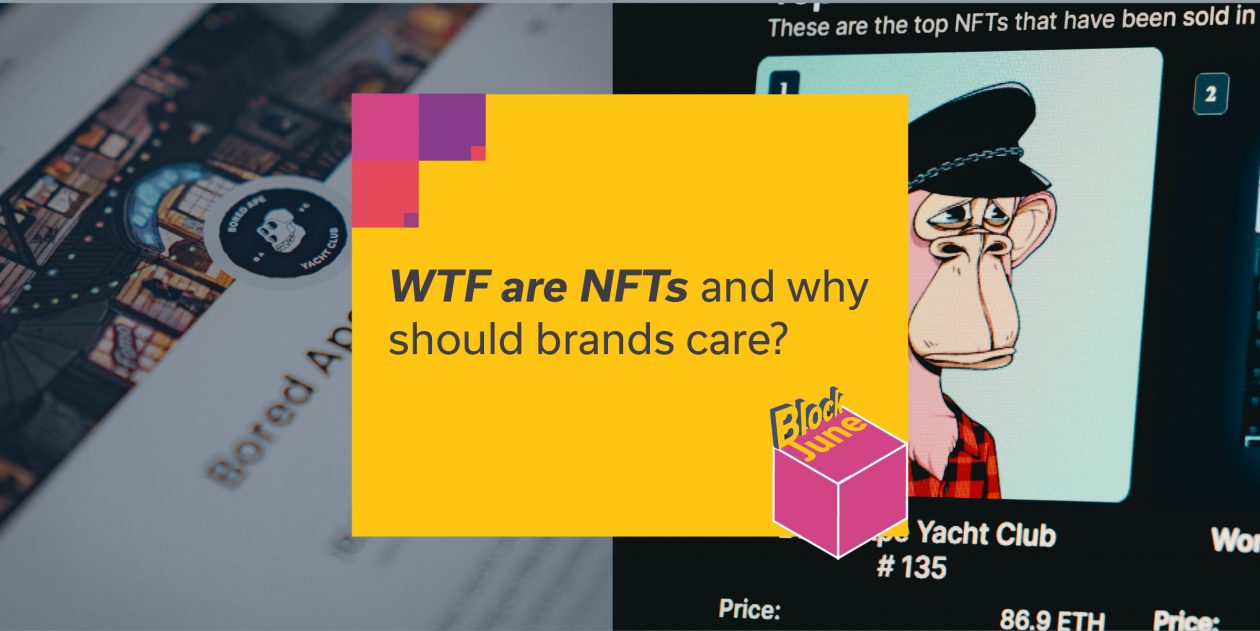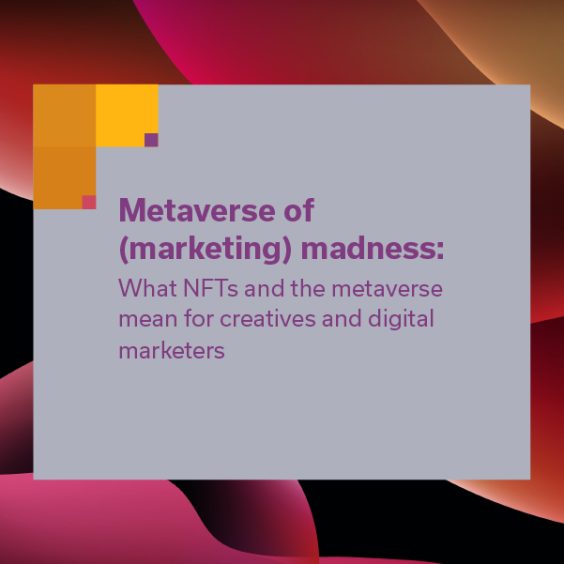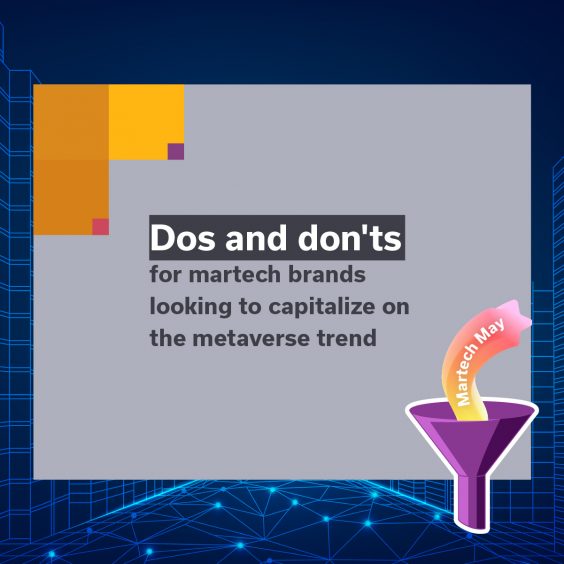NFTs. Everyone’s talking about them. Every week another major brand seems to have jumped on the non-fungible bandwagon, from YouTube to Samsung – even Pringles! Most of the time, when we think of an NFT, we imagine overpriced Bored Apes or perhaps some famous artist selling a digital artwork for millions. One of the most viral UK stories from last year was about a twelve-year-old boy who made £290,000 from whale pixel art – which definitely beats running a lemonade stand.
But there’s a lot more to NFTs than pixel art and overpriced Twitter profile pictures. So, strap in for an intro to NFTs – what are they? How are they being used by brands? And what does the future hold?
WTF does non-fungible token even mean?
Simply put, fungible = mutually interchangeable. If I have a single pound coin, then it has the same inherent value as another pound coin. Currency is fungible, most commodities are fungible, even Bitcoin is fungible. Non-fungible is the direct opposite. If you owned a Picasso painting that got damaged in a fire, you’d be very disappointed if the insurance company offered you a nursery school fingerpainting as compensation – “it’s a painting!”. Your Picasso was non-fungible, as it was (more or less) unique and therefore irreplaceable.
A token in this context simply means a representation of ownership. If you go to the gym, you’re probably given a token for your locker. The same principle applies to non-fungible (and fungible) crypto tokens – they’re a way to represent ownership of something on a blockchain ledger. If you buy an NFT, it’s a little bit like owning the deed to a house. There’s a piece of paper you keep in your safe, and one in a government office, which proves that it’s you who owns that house.
Blockchains are a super secure way to store information on a ledger. Unlike with traditional paper trails, it’s nearly impossible to modify records on a blockchain. When you buy an NFT, that purchase is witnessed by everyone else on the network. So, if someone else comes along and says, “that’s my NFT actually”, the blockchain would be in your corner. Think of it like a contract signing that’s witnessed by everyone else in the world. It’d be hard to argue with the validity of that contract, right?
Why are NFTs being used by artists?
The short (and slightly silly) answer is “because it’s cool and loads of people are doing it”.
The longer (and probably more useful) answer is because it solves many of the problems artists and collectors have faced for centuries. From traditional mediums like paint or print, through to modern digital art and video, all art can benefit from NFTs.
The creator and all owners are stored on a blockchain ledger, so no more disputes about provenance. It’s decentralised, so artists can sell their art directly to collectors without galleries or auction houses charging big commissions. You can even bake ongoing royalties into an NFT, so every time it’s sold on, the artist receives a commission.
It also makes selling art much more accessible. Once upon a time, if you were an artist, you’d have to convince a snooty gallery owner or auctioneer that your picture was worth the canvas it was painted on. For example, you’d never get a 12-year-old pixel artist exhibiting at a major London gallery. With NFT marketplaces, almost anyone has a forum to sell their digital artwork. Whether you like Bored Apes or not, total sales now stand at $1.03 billion – so there’s a market out there!
Why are brands jumping on the bandwagon?
Well, in many cases… “because it’s cool and loads of people are doing it”. And that’s not a slight against brands that have minted (created) their own NFTs. Take Pringles for instance. When they minted their ‘CryptoCrisp’ flavour, they achieved coverage in every major tech publication globally. It’s safe to assume that their web traffic spiked, along with their audience engagement.
And that last bit it key – audience engagement. For brand loyalists, NFTs are an opportunity to collect virtual “special editions”. When I was a child, I liked to collect the toys that came with special editions of Frosties cereal. With NFTs you can do this digitally – while fostering a secondary market for your customers to bid and fight over ownership of your brand’s digital collectables. This is exactly what one of our clients, Aventus Network, is doing with its latest project, VereNFT, which allows luxury brands to design, create, and sell NFTs through their own marketplace.
There’s no doubt that the NFT is a noteworthy marketing tool. With each NFT minted, you’ve created more than just a lead or a purchase. You’ve created a conversation – a much more powerful outcome for any marketer.
What about b2b brands?
Let’s face it, most b2b audiences aren’t keen to own numeric NFT pixel artwork from their cloud accounting platform, or Collectable Karens from their CRM provider. Top decision- makers (mostly) care about the best solution for their business. However, NFTs don’t have to represent art. At the moment, this just happens to be the most prevalent application because it’s consumer facing and (relatively) easily digestible. In fact, NFTs can be used to represent more or less anything.
Let’s take the example of supply chain management – ensuring the quality and verifying the origin of goods and products. With a blockchain, you can attach an NFT to any goods passing through a supply chain. Because of the digital ledger, this provides an immutable and transparent source of truth as to where they’ve come and whose hands they’ve passed through. For perishable goods like food or agricultural produce, this information is a game changer.
Right now, most supply chains work on paper ledgers, so human error (the wrong date written on a page, for instance) can spell disaster. And it’s not just human error that poses a risk – counterfeiting, record tampering and theft are rife. NFTs mitigate or eliminate these risks.
And that’s just the tip of the iceberg. You can use NFTs to represent real estate, digital identities, web domain names, intellectual property, patents, academic credentials and more. In short, anything that requires authentication, transparency and tamper-proofing.
What’s next?
In the early days of the internet, nobody would have dreamed that fully remote working would become a reality. Nobody could have imagined a world where more people checked their online banking app than went into a bank branch. And no one would have predicted the social networking phenomenon.
I know it’s a bold comparison to make, but you cannot get away from the fact that NFTs have an immense breadth and depth of applicability. They’ve already captured the imaginations of millions across the globe, and there’s a new wave of ambitious, fast-growing businesses that are building NFT-based solutions for a wide range of applications.
So, don’t dismiss NFTs as “that Bored Ape thingy” and tar them all with the same brush. The momentum is there, so be prepared for a future infused with non-fungibility.
Learn more about how we’re supporting companies operating in the blockchain space, or get in touch at hello@rlyl.com.



